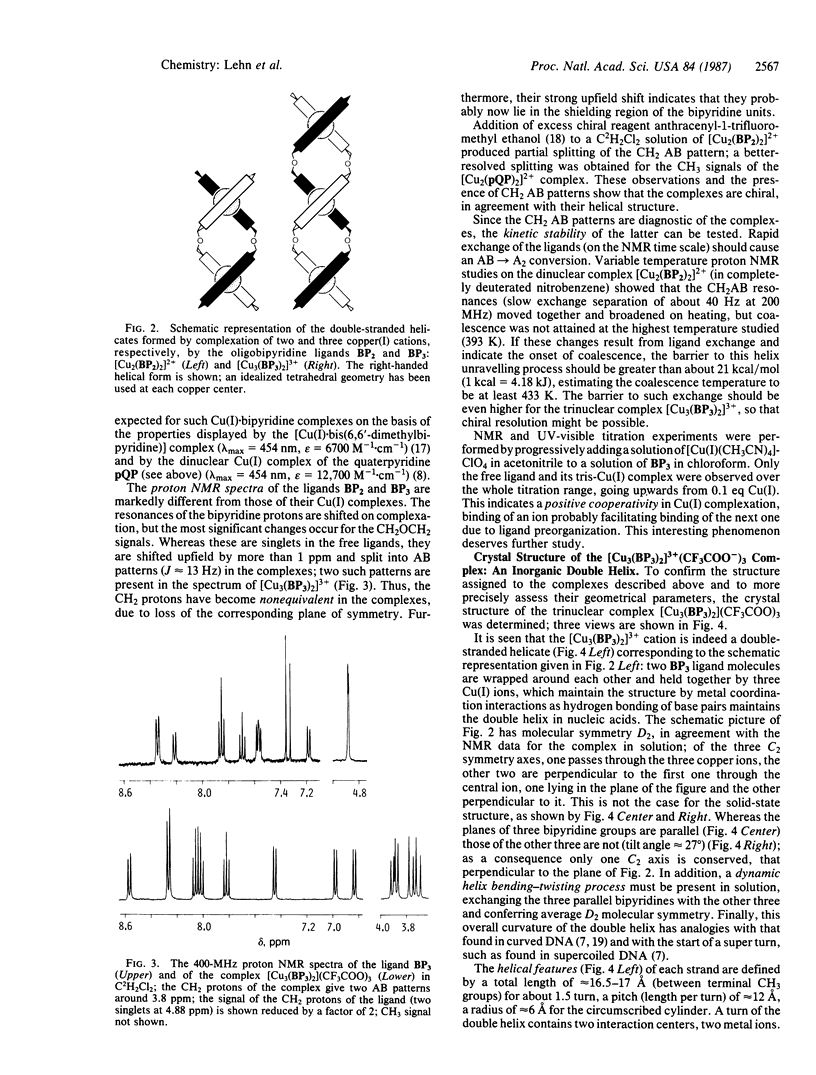Abstract
Two oligobipyridine ligands containing two and three 2,2'-bipyridine subunits separated by 2-oxapropylene bridges have been synthesized and some of their complexation properties with metal ions have been investigated. In particular, with copper(I) they form, respectively, a dinuclear and a trinuclear complex containing two ligand molecules and two or three Cu(I) ions. In view of the pseudotetrahedral coordination geometry of Cu(I) X bis(bipyridine) sites and of NMR data indicating that the present complexes are chiral, one may assign to these dinuclear and trinuclear species a double-helical structure in which two molecular strands are wrapped around two or three Cu(I) ions, which hold them together. These complexes may thus be termed "double-stranded helicates." Determination of the crystal structure of the trinuclear species has confirmed that it is indeed an inorganic double helix, possessing characteristic features (helical parameters, stacking of bipyridine bases) reminiscent of the DNA double helix. This spontaneous formation of an organized structure by oligobipyridine ligands and suitable metal ions opens ways to the design and study of self-assembling systems presenting cooperativity and regulation features. Various further developments may be envisaged along organic, inorganic, and biochemical lines.
Full text
PDF




Selected References
These references are in PubMed. This may not be the complete list of references from this article.
- Arrhenius T. S., Blanchard-Desce M., Dvolaitzky M., Lehn J. M., Malthete J. Molecular devices: Caroviologens as an approach to molecular wires-synthesis and incorporation into vesicle membranes. Proc Natl Acad Sci U S A. 1986 Aug;83(15):5355–5359. doi: 10.1073/pnas.83.15.5355. [DOI] [PMC free article] [PubMed] [Google Scholar]
- Flory P. J., Miller W. G. A general treatment of helix-coil equilibria in macromolecular systems. J Mol Biol. 1966 Jan;15(1):284–297. doi: 10.1016/s0022-2836(66)80228-0. [DOI] [PubMed] [Google Scholar]
- Kelly J. M., Tossi A. B., McConnell D. J., OhUigin C. A study of the interactions of some polypyridylruthenium (II) complexes with DNA using fluorescence spectroscopy, topoisomerisation and thermal denaturation. Nucleic Acids Res. 1985 Sep 11;13(17):6017–6034. doi: 10.1093/nar/13.17.6017. [DOI] [PMC free article] [PubMed] [Google Scholar]
- PAULING L., COREY R. B., BRANSON H. R. The structure of proteins; two hydrogen-bonded helical configurations of the polypeptide chain. Proc Natl Acad Sci U S A. 1951 Apr;37(4):205–211. doi: 10.1073/pnas.37.4.205. [DOI] [PMC free article] [PubMed] [Google Scholar]
- Sigman D. S., Graham D. R., D'Aurora V., Stern A. M. Oxygen-dependent cleavage of DNA by the 1,10-phenanthroline . cuprous complex. Inhibition of Escherichia coli DNA polymerase I. J Biol Chem. 1979 Dec 25;254(24):12269–12272. [PubMed] [Google Scholar]
- Ulanovsky L., Bodner M., Trifonov E. N., Choder M. Curved DNA: design, synthesis, and circularization. Proc Natl Acad Sci U S A. 1986 Feb;83(4):862–866. doi: 10.1073/pnas.83.4.862. [DOI] [PMC free article] [PubMed] [Google Scholar]
- WATSON J. D., CRICK F. H. Molecular structure of nucleic acids; a structure for deoxyribose nucleic acid. Nature. 1953 Apr 25;171(4356):737–738. doi: 10.1038/171737a0. [DOI] [PubMed] [Google Scholar]


